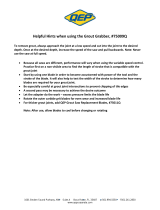Page is loading ...

PACKAGING
Thin Brick is packaged as follows:
1 Box of Flats = 7 square feet
COVERAGE
Calculate the amount of Thin Brick you’ll need for your project:
Measure the width and height of all areas to be covered. Multiply width by height to determine the
total square footage of the surface area.
NOTE: If you intend on dry stacking the product on the wall (no mortar joints) you’ll need 30%
more product. Thin Brick is packaged assuming the product will be installed with a minimum of 3/8”
mortar joint.
MATERIALS CHECKLIST
In addition to the packaged Thin Brick, here are the materials you’ll need when installing the
product:
ITEM PURPOSE
Tarp to cover floor Floor protection
Large Sponge To clean back of brick or eliminate dust
Mortar
For Joints: 1 part masonry cement; 2 parts sand
(As an alternative, use Type S or Type N Mason Mix & Water
Bucket or Wheelbarrow To mix mortar in
Hoe or large mixing stick To mix mortar with
Masonry blade To score & break-off thin brick pieces to fit
Small electric saw - optional To custom-cut thin brick
Mortar / Grout bag To fill in joints
Joint tool To smooth out joints
Stiff brush To wipe away excess mortar
Gloves To protect hands during installation
Safety glasses To protect eyes during installation
Dust mask Protection during mortar mixing
THIN BRICK INTERIOR
INSTALLATION METHODS
Packaging / Coverage / Materials Checklist

Install cement board as per manufacturer’s instructions. If using Fast Adhesive Method, Thin brick may also
be applied directly over water-resistant drywall (“green board” or “blue board”). Applying thin brick directly
over standard untreated drywall may negatively affect joint quality and overall durability.
Step 2: Install Thin Brick
Clean unit backs of any dust, laitance, loose material and any excess film that could impede bond. Start with
the corner pieces, working either from the top-down, or bottom-up. Using a non-sagging adhesive, apply a
generous bead to the back of each brick and firmly press into place on the wall. After the corner pieces are
installed, apply flat pieces starting at an outside corner and working your way in. Let the adhesive dry
overnight. Grout the joints using pointing mortar (or mix shown on Page 4) using a grout bag. Tool joints
when thumbprint hard using a metal jointing tool.
THIN BRICK INTERIOR
INSTALLATION METHODS
Installation Method 1
METHOD 1: FAST ADHESIVE METHOD
Step 1: (Framed Installation) Install Cement Board
Installing Thin Brick and filling in joints
Framed Wall Installation Using
Fast Adhesive Method
1
2
Applying adhesive to back of Thin Brick

Step 1: (Framed Installation) Install Cement Board
Install cement board as per manufacture’s instructions. For new construction, install cement board in place
of sheet rock.
Step 2: Apply Polymer Modified Thin-Set Mortar
Using a trowel, spread mortar across substrate in an upwards direction with the flat side of the trowel. Run
notched side of the trowel across mortar to create a grooved finish. Apply only a workable area of mortar
that will allow veneer to be properly set before surface drying occurs. This area will vary depending on site
environmental conditions.
Step 3: Install Thin Brick Masonry Units
Clean unit backs of any dust, laitance, loose material and any excess film that could impede bond. With a
trowel “back-butter” the veneer units, if required to fill any surface irregularities or to ensure 100% coverage.
Beginning with the corner pieces, work either from the top-down, or bottom-up. Press the corner piece onto
the wall, rotating back and forth slightly, and forcing some of the mortar to “squeeze out”. Remove this
excess mortar with a square flat trowel and use the excess on the next piece of veneer. Remove
excess mortar from around or on the veneer units with a stiff brush. Check for 100% mortar coverage by
removing two stone units from the wall per bag of mortar used. Grout the joints using pointing mortar
(or mix shown on Page 4) using a grout bag. Tool joints when thumbprint hard using a metal jointing tool.
THIN BRICK INTERIOR
INSTALLATION METHODS
Installation Method 2
METHOD 2: STANDARD THIN-SET MORTAR
1
2
3
Installing Thin Brick and filling in joints
Framed Wall Installation Using Thin-Set Mortar

METHOD 3: FLOOR APPLICATION METHOD
THIN BRICK INTERIOR
INSTALLATION METHODS
Installation Method 3 / Mix for Pointing Joints
Additional Information
1. As building codes vary by region, it is important to check local building codes for proper installation guidelines.
2. This Installation Guide serves as reference only and is not meant to act as a substitute for professional advice.
3. Considerations must be made for hot & cold weather construction. For additional information on hot & cold weather construction, refer to TMS 602-11/ACI
530.1-11/ASCE 6-11, Specification for Masonry Structures, Sections 1.8C and 1.8D.
To install thin brick as a floor application, any of the industry-standard methods used to install traditional
tile flooring are acceptable.
NOTE: Thin Brick can be installed by “floating” the joints with grout using a grout release agent. However,
to achieve an authentic brick appearance, use pointing mortar applied with a grout bag and tooled with a
concave joint tool.
MIXING FOR POINTING JOINTS (Proportioned by Volume)
2 PARTS SAND; 1 PART TYPE N MASONRY CEMENT OR MORTAR CEMENT
Warning: The dust generated from dry sawing may contain silica and may be a
potential health problem for the lungs. Wet sawing is recommended.
To view other General Shale products and project ideas visit www.generalshale.com.
If you are not completely satisfied with your purchase or if you would like to share your project with us,
contact us at providence@generalshale.com or call 1-800-414-4661.
/

